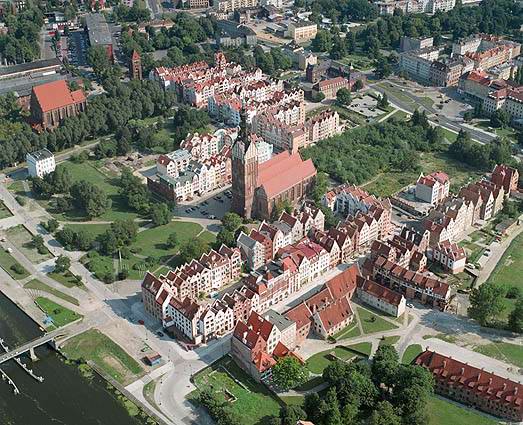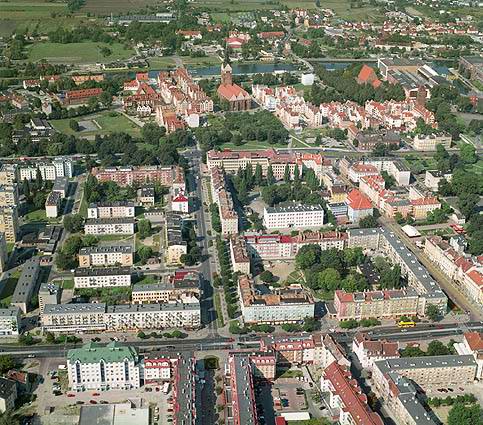Pawian
European
 Have you seen my frog?
Have you seen my frog?
Posts: 3,266
|
Post by Pawian on Sept 9, 2007 4:49:41 GMT -7
Bydgoszcz  Elbląg  Gdańsk  Gniezno  Some village in Hel pensinsula  Jelenia Góra  The most beautiful view is on Kalisz, an old Polish city.  |
|
Pawian
European
 Have you seen my frog?
Have you seen my frog?
Posts: 3,266
|
Post by Pawian on Sept 9, 2007 5:02:25 GMT -7
Most Polish city and town centers look like this: Lublin  The further from the center you drive, the uglier the city becomes: Łódź  |
|
|
|
Post by leslie on Sept 9, 2007 6:31:27 GMT -7
Pawi
Why don't you write 'proper' English and say 'Town Centres' - you're not American are you?!
Leslie
|
|
Pawian
European
 Have you seen my frog?
Have you seen my frog?
Posts: 3,266
|
Post by Pawian on Sept 9, 2007 6:38:21 GMT -7
Pawi Why don't you write 'proper' English and say 'Town Centres' - you're not American are you?! Leslie Why don`t you write "why don`t you write proper British English"? hahahahaha I like diversifying my language.... Besides, there are more Americans here than Brits hahahahaha |
|
Pawian
European
 Have you seen my frog?
Have you seen my frog?
Posts: 3,266
|
Post by Pawian on Sept 9, 2007 6:43:54 GMT -7
Unsurpassed Beauties: Kraków  Leszno  Olsztyn  Poznań  Wrocław  Zamość  Toruń  |
|
Pawian
European
 Have you seen my frog?
Have you seen my frog?
Posts: 3,266
|
Post by Pawian on Sept 9, 2007 6:52:55 GMT -7
Surpassed Uglies: Lubin  Warsaw  Katowice  Gorzów  It`s not my opinion, that`s what people say about those cities, both residents and visitors. |
|
Pawian
European
 Have you seen my frog?
Have you seen my frog?
Posts: 3,266
|
Post by Pawian on Sept 9, 2007 7:13:11 GMT -7
Most cities sustained big damage during the war. Some were reconstructed, some had only their parts reconstructed, some weren`t reconstructed at all but new houses were built on the bulldozer-cleaned area. Examples of a city which wasn`t reconstructed: Lubin Before the war  Lubin was a Paradise.....Lüben war das Paradies, von dem meine Großeltern bis an ihr Lebensende träumten. Es war die Stadt, in der sie ihr Leben viele Jahre nach ihren Vorstellungen gelebt hatten: die Liebe und Freunde gefunden, eine Familie gegründet, den Laden eröffnet... Krisen, Diktatur und Krieg hatten sie ihren Lebenswillen entgegengesetzt. Lubin was a Paradise.....Lüben war das Paradies, von dem meine Großeltern bis an ihr Lebensende träumten. Es war die Stadt, in der sie ihr Leben viele Jahre nach ihren Vorstellungen gelebt hatten: die Liebe und Freunde gefunden, eine Familie gegründet, den Laden eröffnet... Krisen, Diktatur und Krieg hatten sie ihren Lebenswillen entgegengesetzt.Today  A city partly reconstructed: Elbląg. You can see these seperate blocks of houses. It looks quite strange.  The rest of the city was filled with socialist blocks of flats.  |
|
|
|
Post by kaima on Sept 9, 2007 8:43:17 GMT -7
Hi Pawi -
With your posting of photos before & after, it seems you are the person to ask about the necessity of the concrete housing, and perhaps about the full evolution of housing in Poland (and Eastern Central Europe) after the war.
Can you give us a new thread and a fairly comprehensive story on the evolution of housing in Poland after the war and up to the fall of communism or until today?
Even starting with an outline and fleshing it out on occasion in the future - and having the topic open for discussion will be quite an informative gift to us.
For years I was mistakenly telling people that the precast concrete apartment buildings in the Soviet Block were erected to quickly house millions of people after the massive destruction by the Nazis in WW II. Then looking into it, it seems that the concrete apartments came around in the 1960's and later.
What did the Polish people do for housing immediately after the war, the first winter and the first years? How was that shaped by communism vs. free enterprise? How long did it take the new government to set up programs for new housing, and how quickly did the programs become effective? When did the housing crunch ease up, if at all?
Are there distinctive neighborhoods where you can tell by architectural style what was constructed in the 1940/50's, 1960 and following decades?
Kai
|
|
|
|
Post by rdywenur on Sept 9, 2007 9:05:59 GMT -7
Good question Kai. I like the concrete buildings with their red tile roofs. I wish we had those here. I think they are built much better than ours also.
Just the opposite here in US. The further you get out of the city the better it looks.
|
|
Pawian
European
 Have you seen my frog?
Have you seen my frog?
Posts: 3,266
|
Post by Pawian on Sept 11, 2007 2:06:09 GMT -7
Hi Pawi - With your posting of photos before & after, it seems you are the person to ask about the necessity of the concrete housing, and perhaps about the full evolution of housing in Poland (and Eastern Central Europe) after the war. Can you give us a new thread and a fairly comprehensive story on the evolution of housing in Poland after the war and up to the fall of communism or until today? Even starting with an outline and fleshing it out on occasion in the future - and having the topic open for discussion will be quite an informative gift to us. For years I was mistakenly telling people that the precast concrete apartment buildings in the Soviet Block were erected to quickly house millions of people after the massive destruction by the Nazis in WW II. Then looking into it, it seems that the concrete apartments came around in the 1960's and later. What did the Polish people do for housing immediately after the war, the first winter and the first years? How was that shaped by communism vs. free enterprise? How long did it take the new government to set up programs for new housing, and how quickly did the programs become effective? When did the housing crunch ease up, if at all? Are there distinctive neighborhoods where you can tell by architectural style what was constructed in the 1940/50's, 1960 and following decades? Kai I will try to gather information and answer your questions in proper time. The subject is very interesting indeed, so I will do some research on housing in Poland since the war, adding some pictures too. As for your mistaken presumption, yes, it is true that concrete technology on a large scale appeared in late 60s with its peak in 70s. Before they used mainly brick elements. Ready- to-install concrete elements were used to quickly build houses for people from demographic explosion of the 70s. |
|
|
|
Post by Jaga on Sept 11, 2007 7:54:21 GMT -7
|
|
|
|
Post by bescheid on Sept 11, 2007 8:38:23 GMT -7
Jaga Yes to {Plattenbau}, it is an excellent method of construction. It is just the manner of creation of the design. The Communist possessed little imagination in attention of detail and execution of a pleasing design. For Concrete is a very versatile material and application. The method of light weight precasting of industrial buildings is very well developed. The initial slab is hollow cast for light weight and for insulation value on site. Once for the concrete flooring being layed, the precast wall slab is machine raised into place with adjoining sections separated with neoprene rubber gasket to make them air/water tight. Precasting is so extremely versatile with precast designing/exterior finish {crushed stone/colour impregnation/appearance of brick or stone}. www.rifcomksa.com/concrete.htmThe trend now is in light weight. In the stead of heavy concret, steel frame work {old Saxon method of space frame} is constructed as a grid. This is for high floor strength in support of heavy equipment such as medical machines used in imaging. The wall is precast hard foam with exterior use of fiberglass/resin. The finished building is very difficult to distinguish from stone. With over pass/bridge design. The Japanese method of pre-stressing extensive lengths of concrete support. Is the design use of precasting into the support beams {lateral support} plastic pipe as an enclosure for steel cable insertion. As the poured concrete support cures, the enclosed steel cable lengths are placed under very heavy preload and locked into place. This provides the completed lateral support beam, light weight, very high strength and flexibility with out weakening. This method is not always desirable with building design, for often the requirement is for a stable limited flex design. Charles |
|
Pawian
European
 Have you seen my frog?
Have you seen my frog?
Posts: 3,266
|
Post by Pawian on Sept 19, 2007 11:51:35 GMT -7
Chełmno  Tarnów  Sandomierz  Rybnik  Przemyśl  Malbork  |
|
Pawian
European
 Have you seen my frog?
Have you seen my frog?
Posts: 3,266
|
Post by Pawian on Sept 19, 2007 12:03:38 GMT -7
|
|
Pawian
European
 Have you seen my frog?
Have you seen my frog?
Posts: 3,266
|
Post by Pawian on Sept 19, 2007 12:04:05 GMT -7
What city is it?  |
|